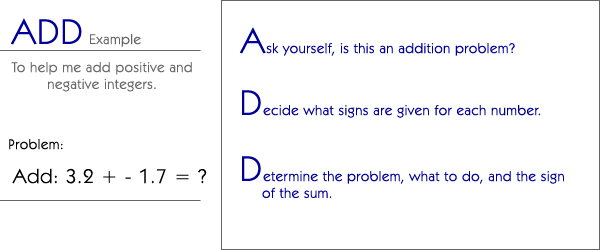 |
|
|||||
|
|
|
|
|
|
|
|
| |
|
|
||||

A sk yourself, is this an addition problem?
-
Look for an addition sign and underline it.
"First I need to make sure this is an addition problem. Here is the addition sign. I am going to underline it to help me remember that I can use the ADD strategy to do this problem."
![]()
D ecide
what signs are given for each number.
-
Look at the problem again. Read it out loud or to yourself. Check for positive and negative signs and circle negative integers.
"Three and two tenths plus negative one and seven tenths. 3.2 is a positive number. 1.7 is a negative number, so I need to circle it."
![]()
D etermine the problem, what to do, and the sign of the sum.
-
"I am going to use the Cue Sheet to help me determine what the sign of the sum will be. I need to do three steps:
First, I need to decide the type of problem. For 3.2 + - 1.7, the first number is positive and the second number is negative so I am going to be looking at the third type of problem, which is a mixed problem.
Second, I know I am working with a mixed problem, so I need to look over at the second column, 'What to do'. For a mixed problem, I need to put the absolute value of the larger number(its positive value) on top and subtract the smaller number's absolute value (its value without a positive or negative sign) from it. That means I will put the 3.2 on top and subtract 1.7 from it. 3.2 - 1.7 is 1.5.
Third, I need to decide what the sign should be - positive or negative. Column three says that the answer should have the sign of the larger number. 3.2 is the larger number and it is positive so my answer is positive 1.5. My problem will look like this:"

| Back to All Strategies |
| |
|
|
|
|
|
|
|
| |
 |
||||||
|
|
|
||||||
| |
|
||||||
| |
|
|
|
|
|||
| |
|
|
|||||